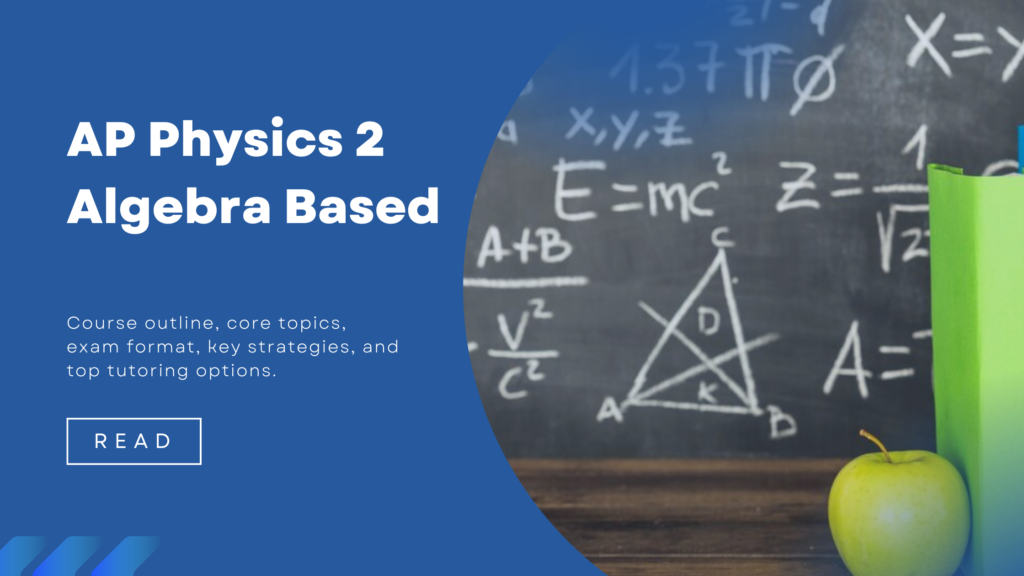In this article, we’ll cover what “AP Physics 2: Algebra Based” is all about, pore over its core concepts and the ways to tackle practice problems, and finally look at expert tips and strategies to help you achieve your highest potential.
What is “AP Physics 2 Algebra based”?
The “AP Physics 2: Algebra based exam” will test your understanding of the scientific concepts, including your ability to use algebra when solving problems related to quantum, atomic, and nuclear physics.
“AP Physics 2: Algebra based” is equivalent to the second course in an introductory college course sequence.
This course will help you gain a deeper understanding of physics through classroom study, in class activities, and inquiry-based laboratory work while exploring concepts like systems, fields, force interactions, optics, change, conservation, and waves.
Before moving ahead with this article, don’t forget to check out more such related articles here:
Equivalency and Prerequisites

To apply for AP Physics 2 Algebra based exam, you ought to know its college-level equivalence and other recommended prerequisites before opting for this course:
· College Course Equivalent:
AP Physics 2 course is equivalent to a second-semester introductory college course in algebra-based physics.
· Recommended Prerequisites:
It is recommended that you ought to have completed AP Physics 1 or a similar introductory physics course. You should also have taken or be currently taking precalculus or an equivalent course.
AP Physics 2 Algebra based outline
The “AP Physics 2: algebra based” course has seven units. They are:
· Unit 1: Thermodynamics – Chapter’s Weightage (Multiple-Choice Section) – 15%–18%
This unit focuses on studying relationships and change. It is important for students to be able to discuss and describe mathematically the effects of changing a physical scenario, such as the consequences of heating or cooling a system.
Topics covered
There are 6 topics in the unit 1. They are:
- Kinetic Theory of Temperature and Pressure
- The Ideal Gas Law
- Thermal Energy Transfer and Equilibrium
- The First Law of Thermodynamics
- Specific Heat and Thermal Conductivity
- Entropy and the Second Law of Thermodynamics
· Unit 2: Electric Force, Field, and Potential – Chapter’s Weightage (Multiple-Choice Section) – 15%–18%
Unit 2 covers electrostatic phenomena at a fundamental level, introducing students to the model of field forces. Despite the shift from gases to charged particles, this unit continues the study of interactions and change.
Topics covered:
There are 7 topics in the unit 2. They are:
- Electric Charge and Electric Force
- Conservation of Electric Charge and the Process of Charging
- Electric Fields
- Electric Potential Energy
- Electric Potential
- Capacitors
- Conservation of Electric Energy
· Unit 3: Electric Circuits – Chapter’s Weightage (Multiple-Choice Section) – 15%–18%
You will study the behavior of charged particles to understand the elements of a circuit, which is the route that an electric current follows.
Topics covered
There are 8 topics in the unit 3. They are:
- Electric Current
- Simple Circuits
- Resistance, Resistivity, and Ohm’s Law
- Electric Power
- Compound Direct Current (DC) Circuits
- Kirchhoff’s Loop Rule
- Kirchhoff’s Junction Rule
- Resistor– Capacitor (RC) Circuits
· Unit 4: Magnetism and Electromagnetism – Chapter’s Weightage (Multiple-Choice Section) -12%- 15%
The concepts presented in Unit 12 are further elaborated in AP Physics C: Electricity and Magnetism. Students will explore the inherent symmetry between electricity and magnetism and the role of electromagnetic induction in powering modern technology.
Topics covered
There are 4 topics in the unit 4. They are
- Magnetic Fields
- Magnetism and Moving Charges
- Magnetism and Current-Carrying Wires
- Electromagnetic Induction and Faraday’s Law
· Unit 5: Geometric Optics – Chapter’s Weightage (Multiple-Choice Section) -12%- 15%
You will learn about the different ways light interacts with materials and how mirrors and lenses form images.
Topics covered
There are 4 topics in this unit. They are:
- Reflection
- Images Formed by Mirrors
- Refraction
- Images Formed by Lenses
· Unit 6: Waves, Sound, and Physical Optics – Chapter’s Weightage (Multiple-Choice Section) -12%- 15%
Unit 6 will explore the behavior of waves, with a particular focus on sound waves. This study will involve understanding how waves can be quantified, covering aspects such as amplitude, wavelength, period, frequency, and wave speed. Additionally, we will examine how light can be understood and modeled as a wave.
Topics covered
There are 9 topics in this unit.
- Properties of Wave Pulses and Waves
- Periodic Waves
- Boundary Behavior of Waves and Polarization
- Electromagnetic Waves
- The Doppler Effect
- Wave Interference and Standing Waves
- Diffraction
- Double-Slit Interference and Diffraction Gratings
- Thin-Film Interference
· Unit 7: Modern Physics – Chapter’s Weightage (Multiple-Choice Section) -12%- 15%
You will explore modern physics concepts and how they address conflicts and questions that Newtonian physics was unable to resolve.
Topics covered
There are 8 topics covered in unit 7. They are:
- Quantum Theory and Wave-Particle Duality
- The Bohr Model of Atomic Structure
- Emission and Absorption Spectra
- Blackbody Radiation
- The Photoelectric Effect
- Compton Scattering
- Fission, Fusion, and Nuclear Decay
- Types of Radioactive Decay
How is “AP Physics 1: Algebra based” course different from “AP Physics 2: Algebra Based” course?
“AP Physics 1: algebra based” and “AP Physics 2: algebra based” courses are designed as introductory college-level physics courses. But here are a few differences between them:
| Feature | AP Physics 1 | AP Physics 2 |
| Course Level | Introductory | Builds upon AP Physics 1 |
| Math Requirement | Algebra II | Algebra II and some precalculus |
| Primary Focus | Mechanics, work, energy, power, waves, sound | Thermodynamics, electricity, magnetism, optics, modern physics |
| Lab Emphasis | Strong emphasis on hands-on experiments | Continued emphasis on experimental design and data analysis |
| Exam Structure | Multiple choice and free response | Multiple choice and free response |
| Recommended Pre-requisite | Algebra II | AP Physics 1 or equivalent |
Exam format for AP Physics 2 Algebra-Based
“AP Physics 2: Algebra based” exam is 3 hours long. It consists of 2 sections:
· Section I
Multiple-choice | 40 Questions | 80 Minutes
· Section II
Free-response | 4 Questions | 100 Minutes
Question 1: Mathematical Routines (10 points).
Question 2: Translational Between Representations (12 points).
Question 3: Experimental Design and Analysis (10 points).
Question 4: Qualitative/Quantitative Translation (8 points each).
Scoring and grading for AP Physics Algebra 2 course
Like all AP exams, the AP Physics 2 exam score is on a scale of 1 to 5.
| Score | Qualification |
| 5 | Extremely well qualified |
| 4 | Well qualified |
| 3 | Qualified |
| 2 | Possibly qualified |
| 1 | No recommendation |
Which is better? Taking “AP Physics Algebra based” classes or self-study
The choice between taking AP Physics Algebra-Based preparatory classes and self-study largely depends on your learning style, time management skills, and access to resources. Ideally, a combination of both can be beneficial.
You can take a class for structured learning and supplement it with self-study for additional practice. Below are some benefits to consider:
· “AP Physics Algebra-Based” Preparatory Classes’ Benefits
There are certain benefits when you enroll for preparatory classes to learn. Few of them are:
Structured learning: Provides a clear curriculum and pacing.
Laboratory experience: Offers hands-on experimentation.
Teacher guidance: Access to expert explanations and feedback.
Peer interaction: Opportunities for study groups and discussions.
· Self-Study
Self-studying requires undisturbed time and consistency. However, there are also certain pros and cons to consider.
Flexibility: Learn at your own time and convenience.
Cost-effective: Potentially cheaper than a formal class.
Self-discipline: Requires strong time management and motivation.
Limited resources: Might lack access to lab equipment and immediate feedback.
Effective strategies for “AP Physic 2: Algebra based” preparation

Here are a few strategies that will help you prepare for your AP Physics Algebra based exams:
· Master the fundamentals
Ensure a strong grasp of algebra, trigonometry, and core physics concepts from AP Physics 1.
· Develop problem solving skills
Practice a variety of problems to build a strong problem-solving intuition. Visualize physical scenarios to aid understanding.
. Focus on time management
Practice solving problems under timed conditions to simulate exam stress. Allocate specific time for each question type.
· Understand the formula sheet
While a formula sheet is provided, understand the derivations and applications of each formula.
· Seek clarification
Don’t hesitate to ask your teacher or peers for help when encountering difficulties. Effective communication is key to understanding complex concepts.
· Seek laboratory experience
Hands-on experiments enhance conceptual understanding. Relate lab findings to theoretical knowledge.
· Look for consistent review
Regular review of topics prevents forgetting and reinforces learning. Utilize flashcards, practice quizzes, and study groups.
How to find the right “AP Physics 2: algebra based” class?
By choosing the right “AP Physics 2 algebra-based class” and dedicating yourself to the coursework, you can build a stronger foundation for future academic and career pursuits. Here is the basic homework that you should do while looking for a good “AP Physics algebra based” preparatory program:
· Research schools and teachers
Look for schools/institutes with experienced physics teachers and strong academic reputations. Ensure the course covers all required AP Physics 2 topics in depth. Consider if the teacher’s teaching style aligns with your learning preferences.
· Consider class size
A small class size often offers more personalized attention and opportunities for interaction with the teacher.
· Explore online options
Online classes offer flexibility in scheduling. You can choose from teachers across the country. However, some online courses might limit laboratory work.
· Read reviews and testimonials
Gain insights into the course’s effectiveness from previous students. Websites like Yelp, Google Reviews, or dedicated education review platforms can provide valuable information.
PrepGenius: Offering the best “AP Physics 2: algebra-based” tutors
PrepGenius is renowned for its exceptional “AP Physics 2: Algebra-Based” tutoring services. With a team of qualified tutors, it offers personalized guidance to help students excel in this challenging subject. It also offers courses for SAP and SAT.
· How to enroll for the course at PrepGenius – Steps
By choosing PrepGenius, you’re investing in your academic success and gaining a competitive edge. Here’s how to enroll at PrepGenius
- Visit the PrepGenius Website: Explore their programs, faculty, and student testimonials.
- Contact Admissions: Contact the admissions team through their website or contact information.
- Provide Necessary Details: Share your academic background, target score, and preferred coaching mode (online or in-person).
- Enrol in the Program: Complete the enrolment formalities and fee payment.
- Commence Your Tutoring: Begin your AP Physics 2 journey with Prep Genius.
Resources for “AP Physics 2: algebra based” sample papers
Here are a few resources to find “AP Physics Algebra based” sample question papers.
· Official Source: The College Board
AP Central: The most reliable source for official AP Physics 2 practice materials. Past exam questions, scoring guidelines, and sample student responses can be found.
· Textbook Publishers:
Some physics textbooks might include practice questions or sample exams.
· Online Prep Courses
Platforms like PrepGenius or other test prep companies offer practice materials.
· Your Teacher
Your AP Physics 2 teacher might have additional resources or practice exams.
Tips to solve AP Physics 2 Algebra-based sample questions
Here are some tips with examples to help you solve “AP Physics 2 Algebra based” sample questions
· Understand the question thoroughly
Example: If a question asks for the net force on an object, identify all forces acting on it (gravity, friction, normal force, etc.) before applying Newton’s Second Law.
· Visualize the problem
Example: For circuit problems, draw a circuit diagram to visualize the components and their connections. This helps in applying Kirchhoff’s rules.
· Identify relevant formulas
Choose the appropriate equations based on the given information.
Example: For a capacitor problem, identify relevant formulas like Q = CV, U = 1/2 CV^2, and C = εA/d.
· Show your work clearly
Example: When solving for an unknown variable, show each step of the algebraic manipulation. This helps in identifying errors and partial credit.
· Check units
Example: Before calculations, ensure all quantities have consistent units (e.g., meters, seconds, kilograms). If units don’t match, there’s likely an error.
· Use diagrams and graphs
Example: For problems involving waves, draw a wave diagram to visualize wavelength, amplitude, and phase difference.
· Understand the physics concepts
Example: While calculations are important, understanding the underlying physical principles is crucial. Relate equations to physical phenomena.
Conclusion
Mastering “AP Physics 2: Algebra-Based” requires dedication, effective strategies, and complete understanding of the course material. By combining classroom learning with diligent self-study, you can develop the skills required to excel on the exam. Remember, consistent practice and a clear knowledge of fundamental concepts are the keys to success.
Frequently Asked Questions for AP Physics 2 Algebra Based
Is AP Physics calculus based or algebra based?
AP Physics 1 and 2 are algebra-based. This means you’ll use algebra and trigonometry to solve problems but won’t need calculus.
AP Physics C is different. It’s divided into two courses:
- AP Physics C: Mechanics
- AP Physics C: Electricity and Magnetism
Both AP Physics C courses are calculus-based. This means you’ll use calculus to solve problems and understand the underlying physics concepts.
What is considered as the hardest topic in AP Physics 2?
While all units in AP Physics 2 present their own challenges, “Unit 7: Optics” is often cited as one of the most difficult. It’s abstract concepts, such as interference and diffraction, can be difficult to
visualize and apply mathematically. Additionally, connecting theoretical knowledge to real-world optical phenomena requires a deeper understanding of the subject
Is AP Physics 2 harder than 1?
Students who are skilled in math and physics, and those who enjoyed AP Physics 1, often find AP Physics 2 easier. However, students who are not interested in physics and struggled to pass AP Physics 1 may find difficulties in AP Physics 2.
Which topics does the “AP Physics 2: algebra-based” course cover?
AP Physics 2: Algebra-Based covers a broader range of physics concepts. They are:
- Modern Physics
- Thermodynamics
- Electric Force
- Field, and Potential
- Electric Circuits
- Magnetism and Electromagnetism
- Geometric Optics
- Waves, Sound, and Physical Optics
Is it possible to self study for AP Physics 2?
Yes, it’s possible to self-study for AP Physics 2. However, it requires strong self-discipline, time management, and access to quality resources. Self-study can be challenging without guidance, so it’s essential to find reliable textbooks, online courses, or tutoring if needed.
Can I take AP Physics 2 without 1?
The AP Physics 2 Algebra based course is equivalent to a second-semester college course. Before taking AP Physics 2, you must have already taken AP Physics 1 or have completed a course in precalculus.
What is the cutoff score for AP Physics 2?
According to The College Board, a score of 3 is qualified, a 4 is well-qualified, and a 5 is extremely well-qualified. Depending on the college or university you plan to attend, credits can be awarded for scores within the 3-5 range.
Is AP Physics 2 harder than C?
No, AP Physics C is harder than AP Physics 2 Algebra based, as the course includes advanced and in-depth curriculum that requires a strong understanding of calculus-based physics concepts.
What are AP Physics 2 FRQ
AP Physics 2 Free Response Questions (FRQs) are essay-style questions that require you to demonstrate your understanding of physics concepts through written explanations, calculations, and diagrams. They assess your ability to apply knowledge, analyze data, and communicate your reasoning effectively.
Where can I find AP Physics 2 Algebra based sample paper?
The College Board’s AP Central is the most reliable source for official AP Physics 2 Algebra-Based sample papers. It provides past exam questions, scoring guidelines, and sample student responses. Some physics textbooks also include practice problems and sample exams.
While other sources can provide practice problems, the College Board’s materials are the most accurate representation of the actual AP exam format and content.

